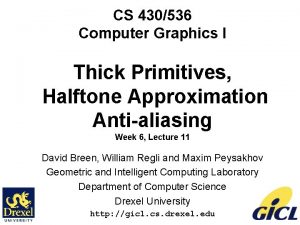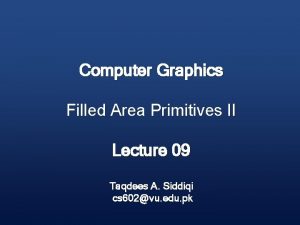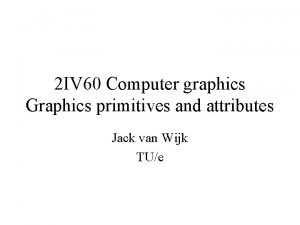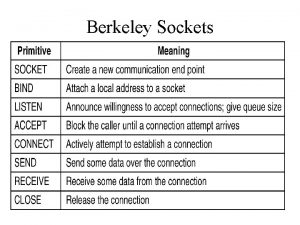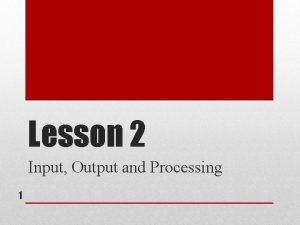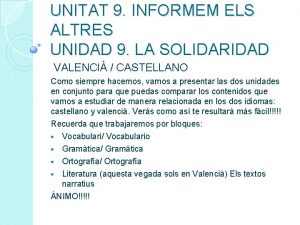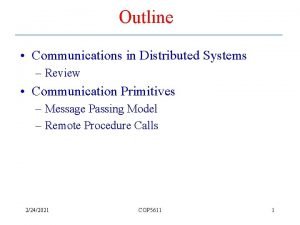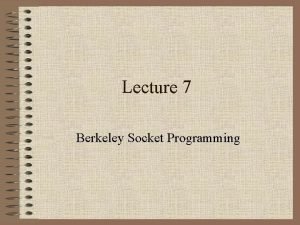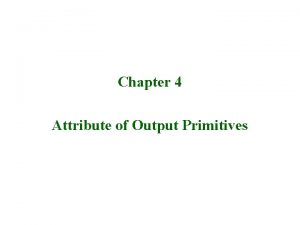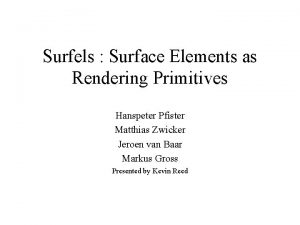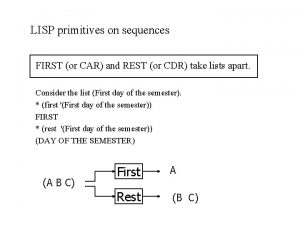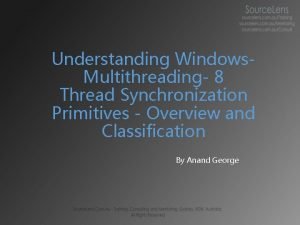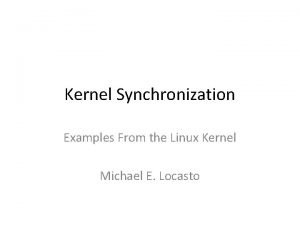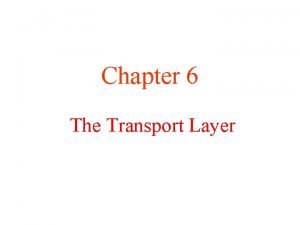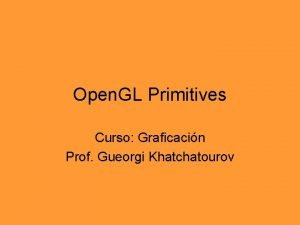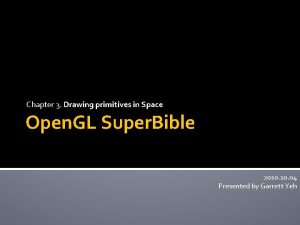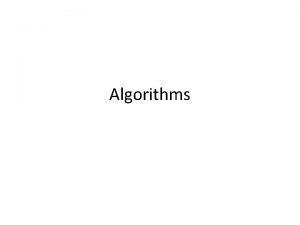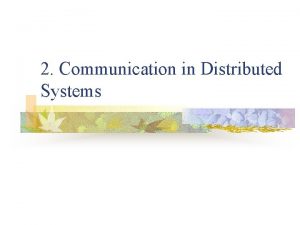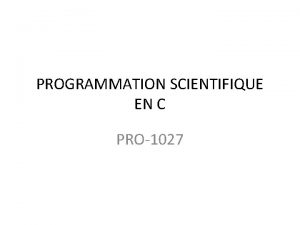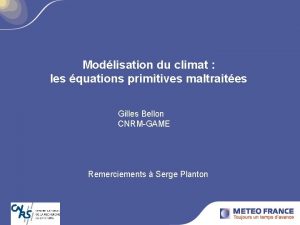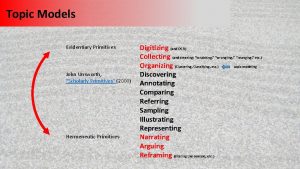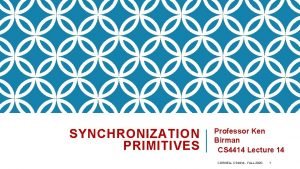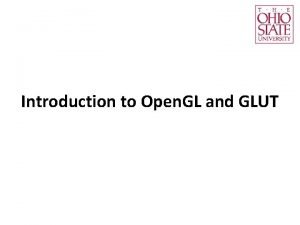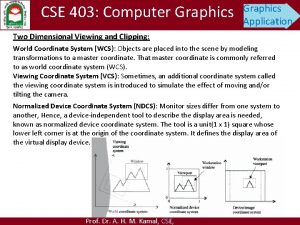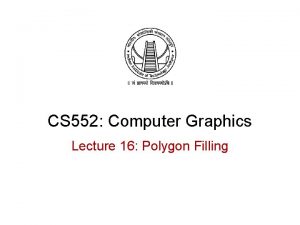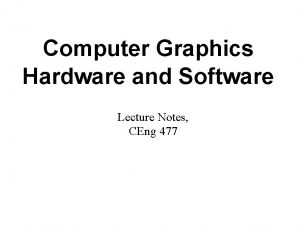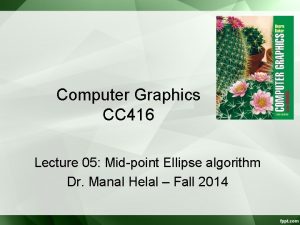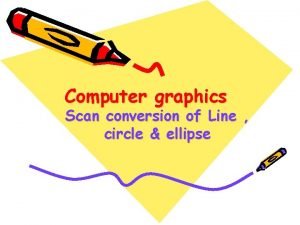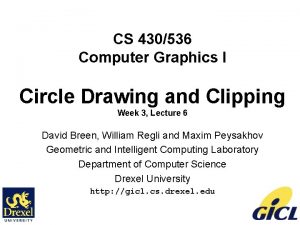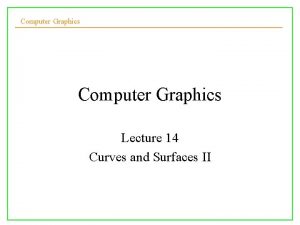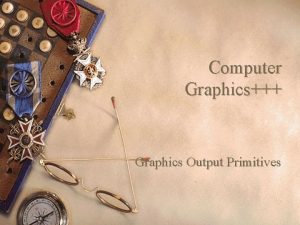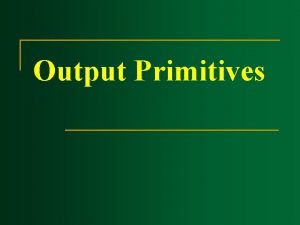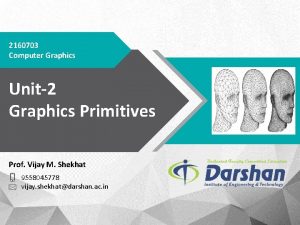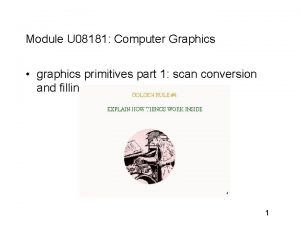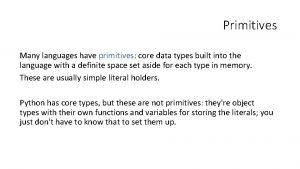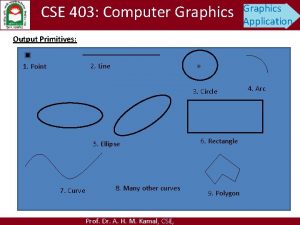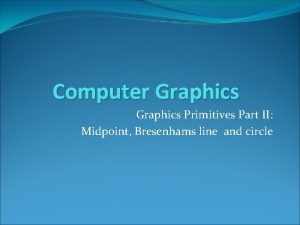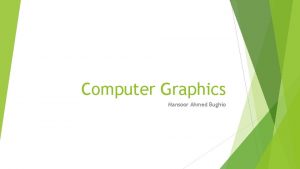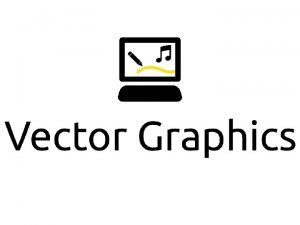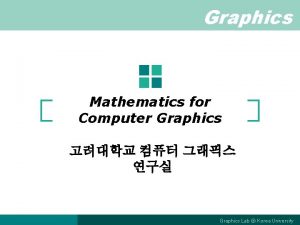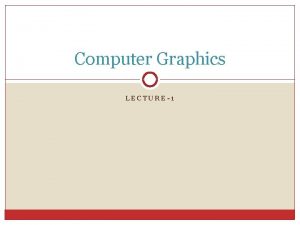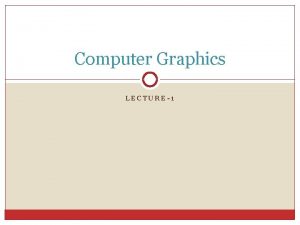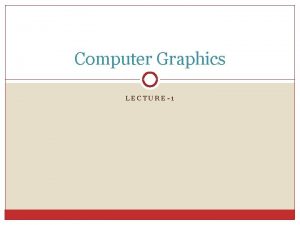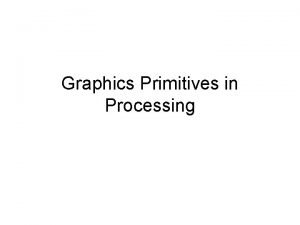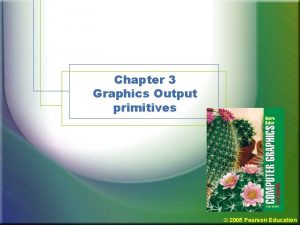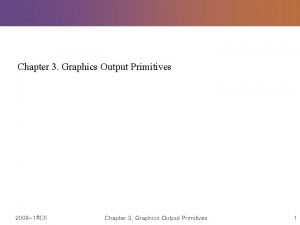2 IV 60 Computer graphics Graphics primitives and





































![Color 1 RGB mode : • color = (red, green, blue) • gl. Color[34][bisf]: Color 1 RGB mode : • color = (red, green, blue) • gl. Color[34][bisf]:](https://slidetodoc.com/presentation_image_h/98a471fe59d485841e32f8890b8a96a3/image-38.jpg)







- Slides: 45

2 IV 60 Computer graphics Graphics primitives and attributes Jack van Wijk TU/e

Overview • Basic graphics primitives: – points, lines, polygons • Basic attributes – linewidth, color

Open. GL output functions gl. Begin(GL_LINES); // Specify what to draw, // here lines // Geometric info via vertices: gl. Vertex*(); // 1 gl. Vertex*(); // 2. . . //. . . gl. End; gl. Vertex[234][isfd] [234]: 2 D, 3 D, 4 D [isfd]: integer, short, float, double For instance: gl. Vertex 2 i(100, 25); H&B 4 -4: 81 -82

Point and Line primitives 3 1 GL_POINTS: 4 2 8 2 4 5 1 3 6 2 1 1 GL_LINES: 7 4 5 3 2 3 sequence of points sequence of line segments GL_LINE_STRIP: polyline 4 5 GL_LINE_LOOP: closed polyline H&B 4 -4: 81 -82

Fill-area primitives 1 • Point, line and curve, fill area • Usually polygons • 2 D shapes and boundary 3 D objects H&B 4 -6: 83 -84

Fill-area primitives 2 • Approximation of curved surface: – Surface mesh or Surface tesselation – Face or facet (planar), patch (curved) H&B 4 -6: 83 -84

Polygon • Polygon: – Planar shape, defined by a sequence of three or more vertices, connected by line segments (edges or sides) – Standard or simple polygon: no crossing edges bowtie polygon H&B 4 -7: 84 -94

Regular polygon • Vertices uniformly distributed over a circle: r H&B 4 -7: 84 -94

Convex vs. concave 1 • Convex: – – All interior angles < 180 graden, and All line segments between 2 interior points in polygon, and All points at the same side of line through edge, and From each interior point complete boundary visible • Concave: not convex H&B 4 -7: 84 -94

Convex vs. concave 2 • Puzzle: Given a planar polygon in 3 D, with vertices Pi, with i = 1, … , N. Give a recipe to determine if the polygon is convex or concave. H&B 4 -7: 84 -94

Convex vs. concave 3 • Puzzle: Given a planar polygon in 3 D, with vertices Pi, with i = 1, … , N. Give a recipe to determine if the polygon is convex or concave. Solution: (multiple solutions possible) H&B 4 -7: 84 -94

Splitting concave polygons H&B 4 -7: 84 -94

Convex polygon triangles Repeat Pick three succeeding points; Join the outside ones with a line; Remove the middle point Until three points are left over Puzzle: Which sequence of points to pick? H&B 4 -7: 84 -94

Inside / outside polygon 1 H&B 4 -7: 84 -94

Inside / outside polygon 2 H&B 4 -7: 84 -94

Inside / outside polygon 3 • General: odd-even rule – Draw a line from C to a point far away. If the number of crossings with the boundary is odd, then C is inside the polygoon. H&B 4 -7: 84 -94

Storage polygons 1 • Mesh: – Vertices – Edges – Faces Operations – Draw all edges – Draw all faces – Move all vertices – Determine orientation –… H&B 4 -7: 84 -94

Storage polygons 2 • Simple: all polygons apart Faces: F 1: V 1, V 2, V 3 F 2: V 1, V 3, V 4, V 5 Per vertex coordinates H&B 4 -7: 84 -94

Storage polygons 3 • More efficient: polygons and vertices apart Faces: F 1: 1, 2, 3 F 2: 1, 3, 4, 5 Vertices: V 1: x 1, y 1, z 1 V 2: x 2, y 2, z 2 V 3: x 3, y 3, z 3 V 4: x 4, y 4, z 4 V 5: x 5, y 5, z 5 V 6: x 6, y 6, z 6 H&B 4 -7: 84 -94

Storage polygons 4 • Also: polygons, edges and vertices apart Faces: F 1: 1, 2, 3 F 2: 3, 4, 5, 6 Edges: E 1: 1, 2 E 2: 2, 3 E 3: 3, 1 E 4: 3, 4 E 5: 4, 5 E 6: 5, 1 Vertices: V 1: x 1, y 1, z 1 V 2: x 2, y 2, z 2 V 3: x 3, y 3, z 3 V 4: x 4, y 4, z 4 V 5: x 5, y 5, z 5 V 6: x 6, y 6, z 6 H&B 4 -7: 84 -94

Storage polygons 5 • Or: keep list of neighboring faces per vertex Faces: F 1: 1, 2, 3 F 2: 1, 3, 4, 5 Vertices: V 1: x 1, y 1, z 1 V 2: x 2, y 2, z 2 V 3: x 3, y 3, z 3 V 4: x 4, y 4, z 4 V 5: x 5, y 5, z 5 V 6: x 6, y 6, z 6 Neighbor faces: 1, 2 1 1, 2 2 2 … H&B 4 -7: 84 -94

Storage polygons 6 • Many other formats possible – See f. i. winged edge data structure • Select/design storage format based on: – Operations on elements; – Efficiency (size and operations); – Simplicity – Maintainability – Consistency –… H&B 4 -7: 84 -94

Polygons in space 1 • 3 D flat polygon in (infinite) plane • Equation plane: Ax + By + Cz + D = 0 z Plane: z=0 y x H&B 4 -7: 84 -94

Polygons in space 2 • Position point (x, y, z) w. r. t. plane: Ax + By + Cz + D > 0 : point in front of plane Ax + By + Cz + D < 0 : point behind plane z Plane: z=0 y x H&B 4 -7: 84 -94

Polygons in space 3 • Normal: vector N perpendicular to plane • Unit normal: |N|=1 Normal: (0, 0, 1) Vlak: z=0 z y x In general: Normal: N=(A, B, C) for Plane: Ax + By + Cz + D = 0 Or N. X+D = 0 H&B 4 -7: 84 -94

Polygons in space 4 z y x H&B 4 -7: 84 -94

Open. GL Fill-Area Functions 1 gl. Begin(GL_POLYGON); // Specify what to draw, // a polygon // Geometric info via vertices: gl. Vertex*(); // 1 gl. Vertex*(); // 2. . . //. . . gl. End; gl. Vertex[234][isfd] [234]: 2 D, 3 D, 4 D [isfd]: integer, short, float, double For instance: gl. Vertex 2 i(100, 25); H&B 4 -4: 81 -82

Open. GL Fill-Area Functions 2 3 1 4 GL_POLYGON: convex polygon 5 3 2 5 4 Concave polygons give unpredictable results. 1 H&B 4 -8: 94 -99

Open. GL Fill-Area Functions 3 • GL_TRIANGLES: 3 6 sequence of triangles 5 1 9 7 2 4 3 8 1 • GL_TRIANGLE_STRIP: 7 5 4 2 6 8 6 5 1 • GL_TRIANGLE_FAN: 4 2 H&B 4 -8: 94 -99 3

Open. GL Fill-Area Functions 4 • GL_QUADS: 4 sequence of quadrilaterals 8 3 1 6 5 2 • GL_QUAD_STRIP: 4 1 10 12 9 strip of quadrilaterals 8 6 2 11 7 3 5 7 H&B 4 -8: 94 -99

More efficiency • Reduce the number of function calls: – Open. GL Vertex Arrays: pass arrays of vertices instead of single ones; • Store information on GPU and do not resend: – Open. GL Display lists; – Vertex Buffer Objects. H&B App. C

Open. GL Display lists 1 Key idea: Collect a sequence of Open. GL commands in a structure, stored at the GPU, and reference it later on + Simple to program + Can give a boost + Useful for static scenes and hierarchical models Not the most modern H&B 4 -15 111 -113

Open. GL Display lists 2 // Straightforward void draw. Robot(); { // lots of gl. Begin, gl. Vertex, gl. End calls } void draw. Scene(); { draw. Robot(); gl. Translate 3 f(1. 0, 0. 0); draw. Robot(); } H&B 4 -15 111 -113

Open. GL Display lists 3 void draw. Robot(); { // lots of gl. Begin, gl. Vertex, gl. End calls } int rl_id; void init(); { rl_id = gl. Gen. Lists(1); gl. New. List(rl_id, GL_COMPILE); draw. Robot(); gl. End. List(); } void draw. Scene(); { gl. Call. List(rl_id); gl. Translate 3 f(1. 0, 0. 0); gl. Call. List(rl_id); } // // get id for list create new list draw your object end of list // draw list // and again H&B 4 -15 111 -113

Open. GL Display lists 4 First, get an id. Either some fixed constant, or get a guaranteed unique one: rl_id = gl. Gen. Lists(1); // get id for list Next, create a display list with this id: gl. New. List(rl_id, GL_COMPILE); drawing commands; gl. End. List(); // create new list // draw something // end of list Finally, “replay” the list. Change the list only when the scene is changed: gl. Call. List(rl_id); // draw list H&B 4 -15 111 -113

Attributes 1 • Attribute parameter: determines how a graphics primitive is displayed • For instance for line: color, width, style • Open. GL: simple state system – Current setting is maintained; – Setting can be changed with a function. H&B 5 -1: 130

Attributes 2 Example: gl. Line. Width(width); gl. Enable(GL_LINE_STIPPLE); gl. Line. Stipple(repeatfactor, pattern); // draw stippled lines. . . gl. Disable(GL_LINE_STIPPLE); Note: special features often must be enabled explicitly with gl. Enable(). H&B 5 -7: 141 -143
![Color 1 RGB mode color red green blue gl Color34bisf Color 1 RGB mode : • color = (red, green, blue) • gl. Color[34][bisf]:](https://slidetodoc.com/presentation_image_h/98a471fe59d485841e32f8890b8a96a3/image-38.jpg)
Color 1 RGB mode : • color = (red, green, blue) • gl. Color[34][bisf]: set color of vertex • For example: – gl. Color 4 f(red, green, blue, alpha) – alpha: opacity (1 transparantie) H&B 5 -2: 130 -131

Color 2 • RGB: hardware oriented model • Dimensions are not natural • (0, 0, 0): black; (1, 0, 0): red; (1, 1, 1) white H&B 5 -2: 130 -131

Color 3 • HSV: Hue, Saturation (Chroma), Value • More natural dimensions • Hue: red-orange-yellowgreen-blue- purple; • Saturation: grey-pink-red; • Value: dark-light H&B 19 -7: 614 -617

Color 4 • HSL: Hue, Saturation (Chroma), Lightness • More natural dimensions H&B 19 -8: 618 -618

Color 5 • Color: big and complex topic • Color: not physical, but perceptual A B

Color 6 • Adelson checkerboard illusion

Color 6 • Adelson checkerboard illusion

Next • We now know how to draw polygons. • How to model geometric objects?
 Circle drawing algorithm in computer graphics ppt
Circle drawing algorithm in computer graphics ppt Thick primitives in computer graphics
Thick primitives in computer graphics Filled vs unfilled polygon in computer graphics
Filled vs unfilled polygon in computer graphics Bundled attributes in computer graphics geeksforgeeks
Bundled attributes in computer graphics geeksforgeeks Filled area primitives in computer graphics
Filled area primitives in computer graphics Raster algorithm
Raster algorithm Computer graphics
Computer graphics What is berkeley sockets
What is berkeley sockets Computer graphics chapter 1 ppt
Computer graphics chapter 1 ppt Data mining primitives languages and system architecture
Data mining primitives languages and system architecture Specialized input devices examples
Specialized input devices examples Pronombres personales fuertes
Pronombres personales fuertes Communication primitives in distributed operating system
Communication primitives in distributed operating system Berkeley socket primitives
Berkeley socket primitives Hadoop i/o
Hadoop i/o Color 3092008
Color 3092008 Blue moon rendering tools
Blue moon rendering tools Lisp primitives
Lisp primitives Crash recovery in transport layer geeksforgeeks
Crash recovery in transport layer geeksforgeeks Synchronization primitives c#
Synchronization primitives c# Output primitives
Output primitives Linux synchronization primitives
Linux synchronization primitives Tcp connection management finite state machine
Tcp connection management finite state machine Gueorgi khatchatourov
Gueorgi khatchatourov Gl primitives
Gl primitives Pseudocode primitives
Pseudocode primitives Buffered vs unbuffered primitives
Buffered vs unbuffered primitives Tableau des dérivées
Tableau des dérivées équations primitives atmosphériques
équations primitives atmosphériques Scholarly primitives
Scholarly primitives C++ synchronization primitives
C++ synchronization primitives Glut functions
Glut functions Two dimensional viewing
Two dimensional viewing Line draw algorithm in computer graphics
Line draw algorithm in computer graphics What is window and viewport in computer graphics
What is window and viewport in computer graphics Shear transformation in computer graphics
Shear transformation in computer graphics Mathematical foundations of computer graphics and vision
Mathematical foundations of computer graphics and vision 2d geometric transformation in computer graphics ppt
2d geometric transformation in computer graphics ppt 8 connected boundary fill algorithm
8 connected boundary fill algorithm Computer graphics hardware and software
Computer graphics hardware and software Midpoint ellipse drawing algorithm solved example
Midpoint ellipse drawing algorithm solved example Circle in computer graphics
Circle in computer graphics Pixel map in computer graphics
Pixel map in computer graphics Raster scan display advantages and disadvantages
Raster scan display advantages and disadvantages Circle and ellipse drawing algorithm in computer graphics
Circle and ellipse drawing algorithm in computer graphics Curves and surfaces for computer graphics
Curves and surfaces for computer graphics

